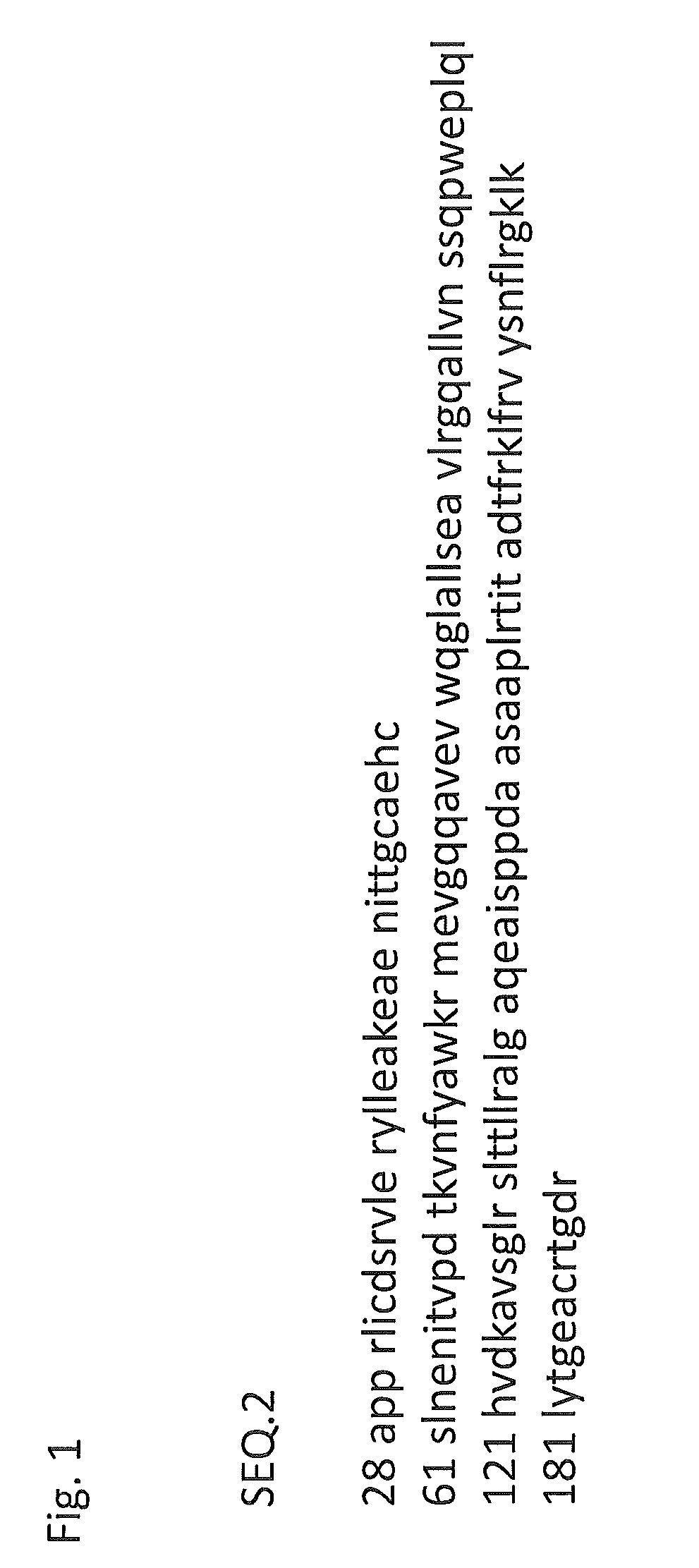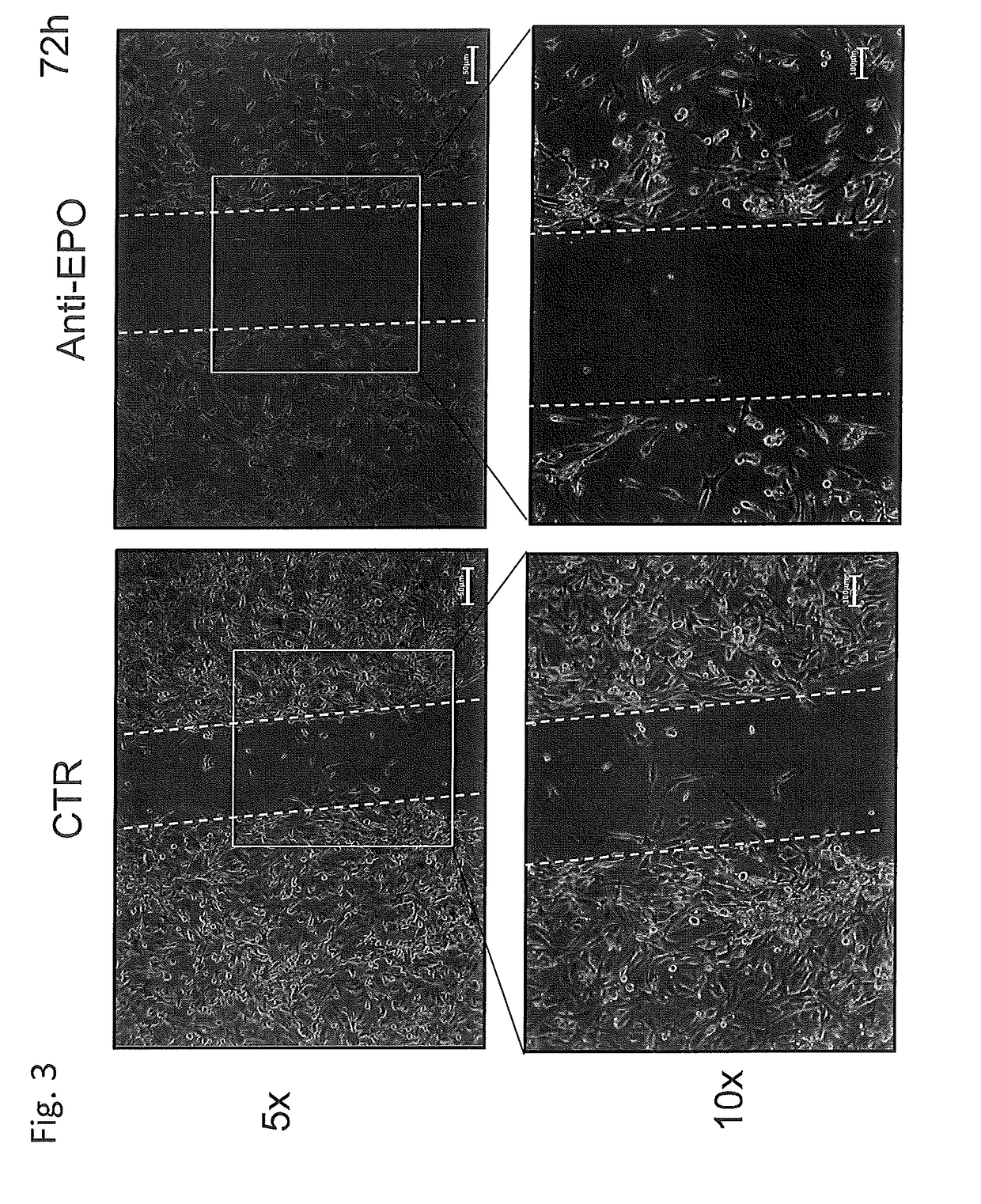Use of negative functional modulators of erythropoietin for therapy
a functional modulator and erythropoietin technology, applied in the field of negative functional modulators of erythropoietin, can solve the problems of serious damage to the neural complex, difficult to identify molecules able to target, and the mechanism underlying the pathobiology of the disease is still poorly understood, so as to reduce the levels of sk1, increase the levels of sk2, and reduce the levels of s1p
- Summary
- Abstract
- Description
- Claims
- Application Information
AI Technical Summary
Benefits of technology
Problems solved by technology
Method used
Image
Examples
example 1
Test of Migration, Invasiveness In Vitro
[0101]SC02 cells are plated in a Boyden Chamber separated by a insert silicone in a growth medium called SCM (Stem Cell Medium) selective for the growth of cancer stem cells. The formulation of the above-mentioned medium is as follows: DMEM / F-12 at a concentration of 1X, solution of antibiotics / antimycotics in the concentration ratio of 1 / 100, apotransferrin at a concentration of 48.82 μg / mL, Insulin at a concentration of 11.5 μg / mL, selenium at a concentration of 2.37 ng / mL, Progesterone at a concentration of 2.88 ng / mL, Putrescine at a concentration of 48.25 μg / mL, Glucose (33 mM), epidermal growth factor (EGF) at a concentration of 10 ng / mL, basic fibroblast growth factor (bFGF) at a concentration of 5 ng / mL, L-glutamine at a concentration of 292 μg / mL, sodium bicarbonate (7.5% weight / vol) (60 μg / m1), Hepes (4-2-hydroxyethyl-1-piperazinyl-ethanesulfonic acid) at a concentration of 1M, heparin at a concentration of 2 μg / mL, bovine serum albu...
example 2
Cell Viability
[0106]SC02 cells were plated in the SCM medium as previously reported and exposed to the following treatments:[0107]Anti-EPO (H-162) (at time 0, replacing the culture medium with culture medium containing 3 μg / m1 of anti-EPO, polyclonal antibody against AA 28-189 of human EPO).[0108]Anti-EPOR (M-20) (at time 0, replacing the culture medium with culture medium containing 10 μg / m1 of anti- EPOR, polyclonal antibody against a C-terminal cytoplasmic domain of human EPOR).[0109]Control (at time 0, replacement of the culture medium).
[0110]The cells were counted with trypan blue to check cell viability every 24 hours after exposure to anti-EPO. The results are reported in the graph in FIG. 14. From 72 hours after the treatment, the cell viability is practically zero.
example 3
Analysis of the Cell Cycle
[0111]The effect on the cell cycle of cell culture treated with anti-EPO antibody (H-162) was estimated by flow cytometry. SC02 cells, 24 hours after plating in SCM medium show the expected profile (FIG. 15). Exposure for 24 hours to anti-EPO leads to the desynchronization of all phases of the cell cycle, resulting in a drastic and early reduction of cell proliferation in the following hours, causing an arrest of cell growth. (FIG. 16).
PUM
| Property | Measurement | Unit |
|---|---|---|
| Cytotoxicity | aaaaa | aaaaa |
Abstract
Description
Claims
Application Information
 Login to View More
Login to View More - R&D
- Intellectual Property
- Life Sciences
- Materials
- Tech Scout
- Unparalleled Data Quality
- Higher Quality Content
- 60% Fewer Hallucinations
Browse by: Latest US Patents, China's latest patents, Technical Efficacy Thesaurus, Application Domain, Technology Topic, Popular Technical Reports.
© 2025 PatSnap. All rights reserved.Legal|Privacy policy|Modern Slavery Act Transparency Statement|Sitemap|About US| Contact US: help@patsnap.com



